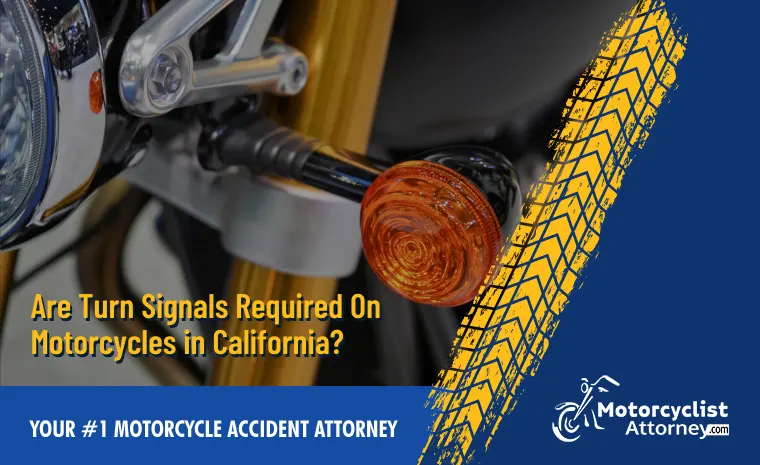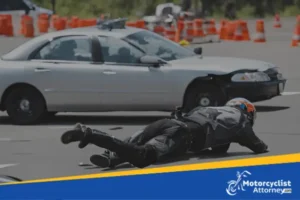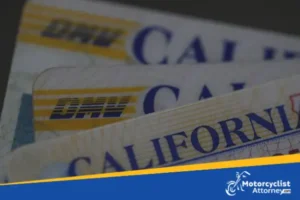Are Turn Signals Required On Motorcycles in California?
Motorcycles, with their sleek designs and dynamic maneuverability, have long been a symbol of freedom on California’s roads. However, this freedom comes with a responsibility to ensure road safety for both motorcyclists and other drivers. One question that many ask – Are turn signals required on motorcycles in California?
In this blog, we will discuss the specifics of California’s motorcycle safety regulations, focusing on the requirement of turn signals, recent changes, and the broader implications for road safety.
Injured in a motorcycle accident?
California’s Motorcycle Safety Regulations
California, known for its stunning landscapes and bustling streets, is home to a vibrant motorcycle culture. To safeguard this culture and promote safety, the state has established rigorous regulations governing motorcycle operation. These regulations encompass a range of aspects, from helmet use to lane splitting. Of particular importance is the use of turn signals, which plays a vital role in preventing collisions, enhancing predictability, and reducing traffic congestion.
California Motorcycle Laws
Turn signals serve as a universal language on the road, conveying a rider’s intentions to change direction to other road users. The significance of turn signal lights is underlined by specific California motorcycle laws that mandate their use. These signals act as a crucial visual cue, allowing nearby motorists to anticipate a motorcyclist’s actions and adjust their driving accordingly. This proactive communication is especially vital for motorcycles, given their smaller profile compared to cars.
California Vehicle Code Section 24950 to 24953 requires all motorcycles to be equipped with operational turn signals on both the front and rear ends. This applies to motorcycles manufactured after January 1, 1973. The turn signals must be visible from a minimum distance of 300 feet under normal daylight conditions.
- California Vehicle Code Section 24950: This section lays down the foundation by stating that every motorcycle operated upon a highway in California must be equipped with turn signal lamps. These lamps should be visible both from the front and rear of the motorcycle.
- California Vehicle Code Section 24951: This section adds specificity by mentioning that the turn signal lamps required under Section 24950 must emit a white or amber light to the front and a red or amber light to the rear. These lights should be visible from a distance of at least 300 feet under normal daylight conditions.
- California Vehicle Code Section 24952: Section 24952 stipulates that the required turn signal lamps should be self-illuminating when the motorcycle is in motion. This means that the lamps should light up on their own when the motorcycle is being ridden.
- California Vehicle Code Section 24953: This is a significant section that outlines the requirement for motorcycles to have turn signals if they were manufactured after January 1, 1973. It states that any motorcycle manufactured after this date must be equipped with these turn signals meeting the criteria specified in the previous sections.
Title 13 of the state’s code, specifically within Division 2, Chapter 2, Article 7, under § 699, also highlights the rules on motorcycle turn signals in California. It includes the mounting requirements for turn signal lamps.
- Turn signal systems on motor vehicles must comprise a minimum of two single-faced or double-faced turn signal lamps located on or in close proximity to the front, along with a minimum of two single-faced turn signal lamps situated at the rear. This stipulation applies universally to all types of motor vehicles operating on California’s roadways, including motorcycles as well.
- Front and rear lamp-type turn signal systems installed on motorcycles must be spaced at a minimum distance of 23 cm (9 inches) apart. However, a deviation from this requirement is noted for front turn signals on motorcycles manufactured after January 1, 1973, which must be separated by at least 40 cm (16 inches).

Motorcycle Accident Rates: The Data Speaks
Motorcycle riders continue to have a disproportionately high presence in fatal traffic accidents. In the year 2021, a total of 5,932 motorcyclists lost their lives, accounting for 14% of the total traffic-related fatalities. According to the National Highway Traffic Safety Administration (NHTSA), this marks the highest recorded number of motorcycle-related fatalities since at least 1975.
A study by the Society of Automotive Engineers also states that neglecting the use of these turn signals leads to motor vehicular accident rates exceeding those caused by distracted driving by more than twofold. The study reveals a troubling trend across the US, with drivers failing to employ their turn signals in nearly half of lane-changing instances. Additionally, an alarming 25% of motorists neglect to signal when executing a turn.
The impact of using turn signals on accident rates cannot be underestimated. Failure to use proper turn signals is a contributing factor in a significant number of accidents involving motorcycles. Accidents caused by the lack of turn signal usage often result in serious injuries or fatalities due to the sudden and unexpected changes in direction.
Injured in a motorcycle accident?
What To Do in Case of A Motorcycle Accident?
In the event of a motorcycle accident, knowing how to respond is crucial for both safety and legal protection. Begin by ensuring your safety and that of others involved. Contact the police to create an official record, and gather information and evidence from the scene, including witness details and photographs.
Seeking medical attention, notifying your insurance company, and consulting with a skilled lawyer are your next vital steps. A motorcycle accident attorney‘s expertise can guide you through complex legal processes, helping you understand your rights and secure fair compensation for damages. By following these steps, you can navigate a motorcycle accident with confidence and maximize your chances of a smooth recovery.
Motorcyclist Attorney provides expert-level legal advice and representation in California. With our team of experienced legal practitioners and motorcycle experts, Motorcyclist Attorney is passionate about making sure your rights as a rider are protected.
Navigating the Road Ahead Safely
Are turn signals required on motorcycles in california? Yes. Every motorcyclist plays a vital role in ensuring the safety and harmony of traffic. In addition to careful lane sharing, additional protective padding, and installation of fog lamps, turn signals help ensure safe travel for motorcyclists. It also serves as a beacon of responsibility, enabling them to communicate their intentions effectively.
As we continue to celebrate the freedom of the open road, let’s remember that this freedom comes with a shared commitment to safety. By adhering to California’s motorcycle turn signal regulations, we contribute to a safer road environment for everyone—motorcyclists and other road users alike.
So, let’s turn on those tail lights, check rearview mirrors, navigate intersections with care, and ride on safely.
However, if you get injured in a motorcycle accident and are not responsible for what happened, you might be eligible to file a claim. Contact us today for a free, no-obligation consultation. We are available 24/7 to take your call.




